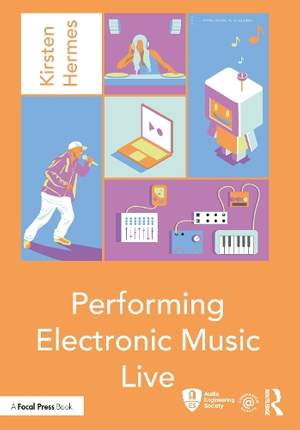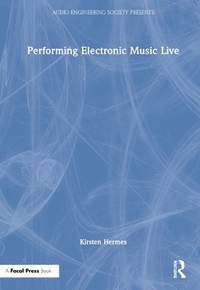
Performing Electronic Music Live
- Author: Hermes, Kirsten
Book
$55.75Contents
- Chapter 1 - General Advice
- 1. The concept
- 2. Confidence and preparation
- 2.1 Effective rehearsal
- 2.2 Dealing with stage fright
- 2.3 Stepping into the performance persona
- 2.4 Using feedback and being prepared for rejection
- 3. Quality of the production
- 4. Factors that determine the setup choice
- 4.1 The music - genre and composition
- 4.2 The act - personality, motivation and skills
- 4.3 Band members and skills
- 4.4 The performance situation
- 4.4.1 The audience
- 4.4.2 The venue and playback system
- 4.4.3 Risk
- 4.4.4 Budget
- 4.4.5 Need for portability
- Tutorial and takeaway points
- 5. References
- Chapter 2 - DAWs and Controllers
- 1. Non-linearity of time
- 2. Overview of performance DAWs
- 2.1 Ableton Live
- 2.2 Bitwig
- 2.3 Maschine
- 2.4 Logic Pro X
- 2.5 Motu Digital Performer
- 2.6 FL studio
- 2.7 Standalone hardware DAW equivalents
- 3. Plugging in hardware
- 3.1 Live arrangement
- 3.2 One-shots and finger drumming
- 3.3 Performing on software instruments
- 3.4 Controlling audio effects
- 3.5 Other external hardware
- 4. Prepared musical material and live recording
- 5. Collaboration
- 6. Randomness and generative approaches
- 7. Customising the performance interface
- 8. Performing live in more studio-oriented DAWs
- 9. Working with visuals
- 10. Recording the show
- Tutorial
- From a complex studio production to an intuitive live set
- Looping clips
- One-shots
- Follow actions
- Live effects
- Live keys and vocals
- Visuals
- 11. Takeaway points
- References
- Interview with Robert Henke
- Chapter 3 - MIDI and CV Performance Controllers
- 1. CV/GATE
- 2. The MIDI protocol
- 2.1 MIDI messages in the MIDI 1 protocol
- 2.2 MIDI 2.0
- 3. Types of performance controllers
- 3.1 Buttons
- 3.2 Continuous signals: knobs, faders, sliders
- 3.3 Controllers that resemble traditional musical instruments.
- 3.4 Modular controllers
- 3.5 Motion-controlled performance hardware
- 3.6 Turning non-musical hardware into MIDI controllers
- 3.7 MIDI Polyphonic Expression
- 3.8 Sequencers
- 3.9 Clock signals and MIDI routing
- Tutorial
- 4. Takeaway points
- References
- Chapter 4 - DJing and Turntablism
- 1. A short history of DJing
- 2. Types of DJ in the present day
- 2.1 Touring artist-DJs
- 2.2 Resident DJs
- 2.3 Mobile event DJs
- 2.4 Radio DJs
- 2.5 Online DJ-producers
- 3. DJ techniques
- 3.1 Mixing techniques and turntablism
- 3.2 Virtuoso turntablism
- 3.3 Effects and audio processing
- 3.4 Programming
- 4. DJ tools available today
- 4.1 DJ software and hardware controllers
- 4.2 CDJs
- 4.3 Going retro: using Vinyl for DJing
- 4.4 Headphones, monitors and microphones
- 4.5 Streaming tracks from online platforms
- Tutorial: three DJ setups presented by Dan Murray
- Preparation
- DJ skills and techniques
- Beatmatching on vinyl
- Getting creative on CDJs
- Working with a hybrid setup
- Performance styles
- 5. Takeaway points
- References
- Interview with Alex M.O.R.P.H
- Chapter 5 - Incorporating Acoustic Instruments and Vocals
- 1. Traditional instruments in electronic music
- 2. Fusion genres
- 3. Live instruments and vocals that are not on the record
- 4. Instruments that are on the record but not on stage
- 5. Microphones and DI boxes
- 6. Effects and sound manipulation
- 6.1 Vocal effects processing
- 6.2 Vocoders and talk boxes
- 6.3 Effects for other instruments
- Tutorial - generated live vocal harmonies, violin and synth
- 7. Takeaway points
- References
- Interview with Matt Robertson
- Chapter 6 - Live Synthesis and Sound Design
- 1. Synthesis technology
- 1.1 Synthesis techniques
- 1.1.1 Additive synthesis
- 1.1.2 Subtractive synthesis
- 1.1.3 FM synthesis
- 1.1.4 Waveshaping synthesis
- 1.1.5 Sampling
- 1.1.6 Granular synthesis
- 1.1.7 Wavetable synthesis
- 1.1.8 Physical modelling synthesis
- 1.2 Controls typically found on commercial synthesizers
- 1.2.1 Oscillators
- 1.2.2 Amplifier
- 1.2.3 Amplitude envelope
- 1.2.4 Filters
- 1.2.5 Modulation
- 1.2.6 Clock
- 1.2.7 Effects, sequencing and arpeggiators
- 1.2.8 Playback controls
- 2. A rich history of artists shaping their sound through synthesis
- 2.1 Retro-leaning synths used by current artists
- 3. A brief history of sampling
- 4. Using synths and samplers on stage
- 4.1 Playing live on hardware synthesizers and samplers
- 4.1.1 Choosing hardware synths
- 4.1.2 Working with pre-programmed sequences
- 4.1.3 Modular synthesizers on stage
- 4.2 Performing live with software synthesizers
- Tutorial
- 5. Takeaway points
- References
- Chapter 7 - Performing without a Laptop
- 1. Building blocks of a laptop-free setup
- 1.1 Sound sources
- 1.2 Control signal generators
- 1.2.1 Clock signal generators
- 1.3 Control signal routing tools
- 1.4 Sound processors and effects
- 1.5 Mixers
- 2. All-in-one hardware tools
- 3. Cabling and connections
- Tutorial: a modular synthesizer setup (Matt Gooderson)
- Modular Systems
- Components of the Hardware Setup
- Melody
- Rhythm
- Sound Sources
- Utility Modules
- Multiple
- Quantiser
- Sample and Hold
- Mixer
- Audio Modifiers
- Composition and Performance
- 4. Takeaway points
- References
- Chapter 8 - Programming Custom Performance Tools
- 1. Getting started with programming
- 1.1 What is a program?
- 1.2 What programming language should you learn?
- 2. Inspiring artist examples
- 2.1 Complete playback solutions
- 2.2 Effects plug-ins and software instruments
- 2.3 Expanding the functionality of hardware
- 2.4 Automatic performance tools
- 2.5 Letting the outside environment control the sound
- Tutorial: introducing BBC R&D's Audio Orchestrator, featuring Jon Francombe and Stephen Davismoon
- How does Audio Orchestrator work?
- The Sequences page
- The Controls page
- The Audio page
- The Appearance page
- The Export page
- 3. Patch It: modular music programming environments
- 3.1 Max/MSP
- 3.2 Pure Data
- 3.3 Other node-based programming environments
- 3.4 Node-based programming in action
- 3.4.1 Effects processing
- 3.4.2 Generative music
- 3.4.3 Sampling and sequencing
- 3.4.4 Working with external hardware
- 3.4.5 Theatre shows
- Tutorial: generative music in Max / MSP, featuring Francesc Moya Serra
- First steps and audio output
- Metronome and timing
- Sound triggering with the select object
- Using MIDI notes to perform on a VST synth
- Random pitches in a subpatch
- Adding further complexity
- Random note velocities and durations
- Modulating synthesis parameters
- Fitting the random note pitches to a musical scale
- Percussion
- The performance GUI
- 4. Live coding: making EDM with algorithms
- Tutorial: an introduction to SuperCollider, featuring Eli Fieldsteel
- The interface
- Getting started
- Oscillator UGens
- Cross-fading between sounds
- Working with pre-recorded audio samples
- What else is possible in SuperCollider?
- 5. Takeaway Points
- References
- Interview with Holly Herndon
- Chapter 9 - Building Custom Hardware Tools
- 1. New instruments built from scratch
- 2. The human body as musical instrument
- 3. Adding functionality to existing instruments
- 4. Performing music on toys and household items
- 5. How can you get started?
- Tutorial: Optical Theremin inside a Game Boy Shell with Rainbow Trash (Dominique Pelletier)
- What you will need
- Casing
- Electronics
- Testing connections
- Soldering connections
- Closing up the case
- Other things you can do...
- 6. Takeaway points
- References
- Chapter 10 - The Performance Setting
- 1. Common live sound technology
- 2. The soundcheck
- 3. Live sound mixing
- 4. Spaces
- 4.1 Arenas and stadiums
- 4.2 Large Festivals
- 4.3 Nightclubs
- 4.4 Warehouse raves
- 4.5 Concert halls
- 4.6 Outdoor theatres
- 4.7 Small and intimate shows
- 4.8 Controlled acoustic spaces
- 4.9 Installations
- 4.10 Remote settings and streaming
- Tutorial: a large redundancy playback rig, featuring Steven Massey
- Stems for playback
- Uninterruptible power supply
- Redundancy playback rig
- Output routing via a split rack
- The monitor mix
- The live mix
- 5. Takeaway points
- References
- Interview with Laura Escude
- Chapter 11 - Stage Design and Visual Parameters
- 1. Tools for creating visual interest
- 1.1 Moving visuals
- 1.2 Lighting
- 1.3 Dancing and acting
- 1.4 Fashion
- 1.5 Stage design
- 2. What determines the choice of visual stage parameters?
- 2.1 Artist identity
- 2.2 Visual parameters that convey a narrative
- 2.3 Creating an abstract connection between what is seen and heard
- 2.4 Amplifying performance parameters
- Tutorial
- 3. Takeaway points
- References
- Chapter 12 - Planning and Promotion
- 1. Music branding principles
- 1.1 Artist identity
- 1.2 Target audience
- 2. Creating marketing materials
- 2.1 Visual materials
- 2.2 Biography
- 2.3 Press release
- 2.4 Website
- 2.4.1 A clear representation of the artist image
- 2.4.2 Layout and content
- 2.4.3 Search engine optimization
- 2.5 Social media
- 2.6 Hardcopy marketing materials
- 3. Networking and gig opportunities
- Tutorial: music industry Dos and Don'ts presented by Woody van Eyden
- Where am I now?
- Where do I want to be?
- What do I need to do to get there?
- Who can help me?
- What should I do in terms of networking?
- 4. Takeaway points
- References
- Chapter 13 - Conclusion
- 1 What do electronic musicians do on stage?
- 2 What constitutes a great electronic music performance?
- 3 How do I choose the concept for my show?
- 3.1 A compelling Performance persona
- 3.2 Virtuosic skills
- 3.3 Technical know-how
- 3.4 A compelling performance setting
- 3.5 Liveness
- 3.6 Core values
- 3.7 Visual interest
- 4 What does my audience expect?
- 5 I am quite shy but I would like to perform live. What can I do?
- 6 I cannot play any instruments or sing. Can I still perform live?
- 7 Should I be a solo artist or form a band?
- 8 What kind of tools do I need to perform electronic music live?
- 9 There are so many different options. What is the right setup for me?
- 10 Who creates electronic performance equipment?
- 11 Where can I try out and buy performance equipment?
- 12 I produce music in a DAW. How can I turn this into a live show?
- 13 Should my live show sound like my record?
- 14 What does "live" mean? Should every sound be created in the moment, or are backing tracks acceptable?
- 15 Is it bad to mime and pretend that I am doing something on stage when I am not?
- 16 I have never produced any music. Where do I begin?
- 17 How should I prepare for my show?
- 17.1 Practice
- 17.2 Sound check
- 17.3 Feedback
- 18 How can I find gig opportunities?
- Thank you!



